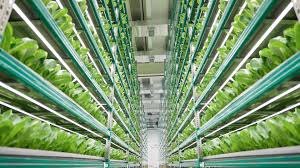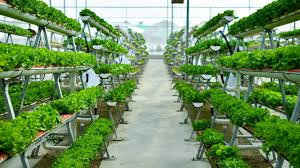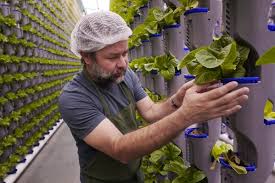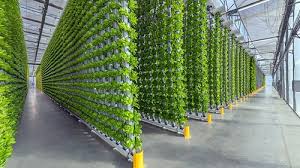Vertical farming is an innovative method of growing crops in vertically stacked layers or structures, often indoors, using controlled environments. Unlike traditional farming, which requires large areas of land, vertical farming maximizes the use of space by growing crops upwards rather than outwards.
It relies on advanced technologies like hydroponics, aeroponics, and artificial lighting to provide plants with the necessary nutrients, light, and water.
This method of farming is gaining popularity as it addresses several challenges faced by conventional agriculture, such as limited arable land, unpredictable weather conditions, and the need for sustainable food production. Vertical farming allows crops to be grown year-round, often with higher yields and less water use, making it an attractive solution for urban areas and regions with limited agricultural space.
Benefits of Vertical Farming
Vertical farming offers numerous advantages that make it a sustainable and efficient way to produce food. Some of the key benefits include:
1. Space Efficiency: Vertical farming utilizes vertical space, allowing more crops to be grown in a smaller area. This is especially beneficial in urban environments where land is limited.
2. Water Conservation: Vertical farming systems often use hydroponics or aeroponics, which require significantly less water than traditional soil-based farming. Water can also be recycled within the system, reducing overall usage.
3. Year-Round Production: Since vertical farming is typically done indoors in controlled environments, crops can be grown year-round without being affected by seasonal changes or extreme weather.
4. Reduced Pesticide Use: Because vertical farms are often located indoors, they are less vulnerable to pests and diseases. This means there is less need for chemical pesticides, resulting in healthier, more organic crops.
5. Proximity to Consumers: Vertical farms can be established close to urban centers, reducing the distance food needs to travel from farm to consumer. This helps cut down on transportation costs and reduces the carbon footprint of food production.
6. Improved Food Security: Vertical farming allows for local food production, even in areas with poor soil quality or limited arable land. This can help improve food security in regions that depend on imported goods.
Types of Vertical Farming Systems

There are several types of vertical farming systems, each with its own advantages and applications. Understanding these systems can help you choose the best one for your needs:
1. Hydroponics: In a hydroponic system, plants grow in a nutrient-rich water solution without the use of soil. This method allows for faster growth and higher yields, as plants can absorb nutrients directly from the water. Hydroponic systems can be set up in stacked layers to maximize space.
2. Aeroponics: Aeroponic systems grow plants by suspending their roots in the air and misting them with a nutrient solution. This method uses even less water than hydroponics and allows plants to receive oxygen directly, promoting faster growth. Aeroponic systems are ideal for growing leafy greens and herbs.
3. Aquaponics: Aquaponics combines hydroponics with aquaculture (fish farming). In this system, fish waste provides nutrients for the plants, while the plants help filter and clean the water for the fish. This closed-loop system is highly sustainable and can produce both crops and fish for consumption.
4. Vertical Towers: Vertical towers are a type of hydroponic system where plants are grown in vertical columns or tubes. These towers can be stacked or arranged in rows to create a high-density growing environment. Vertical towers are often used for growing leafy greens and herbs.
5. Stacked Shelves: Stacked shelf systems use multiple levels of shelves to grow crops. Each shelf has its own light source and irrigation system, allowing for controlled growth in small spaces. These systems are commonly used in indoor vertical farms.
Choosing Crops for Vertical Farming
Not all crops are suitable for vertical farming. Some plants require too much space or specific growing conditions that are difficult to replicate in a vertical farm. However, many crops thrive in vertical systems, especially those that grow quickly and don’t need a lot of root space. Here are some of the best crops for vertical farming:
1. Leafy Greens: Lettuce, spinach, kale, and other leafy greens are ideal for vertical farming. They grow quickly, require little space, and can be harvested multiple times.
2. Herbs: Basil, mint, parsley, and other herbs do well in vertical farming systems. They don’t need much room and can be grown in high densities.
3. Microgreens: Microgreens are young plants harvested early for their flavor and nutrition. They grow quickly and can be grown in large quantities on stacked shelves or trays.
4. Strawberries: Strawberries can be grown in vertical towers or hanging systems. They require careful attention to temperature and humidity but can produce high yields in a controlled environment.
5. Peppers and Tomatoes: Small fruiting plants like peppers and tomatoes can be grown in vertical farming systems, particularly in hydroponic or aeroponic setups. However, they require more space and nutrients than leafy greens.
6. Cucumbers and Beans: Vining plants like cucumbers and beans can also be grown in vertical farms with the help of trellises or support structures. These crops may require more attention but can yield high-quality produce.
Setting Up Vertical Farming Indoors
Setting up a vertical farm indoors requires careful planning and attention to detail. Here’s a step-by-step guide to help you get started:
1. Choose the Right Space: The first step in setting up your indoor vertical farm is to choose a suitable space. This could be a spare room, basement, or even a small greenhouse. Make sure the space has access to electricity and ventilation.
2. Select a Vertical Farming System: Based on the crops you want to grow and the space available, choose a vertical farming system that suits your needs. Hydroponic and aeroponic systems are common choices for indoor farms.
3. Set Up Shelves or Towers: Install shelves or vertical towers to hold your plants. Ensure that each level has adequate space for the crops to grow and access light.
4. Install Grow Lights: Indoor farms need artificial lighting to provide the necessary light for photosynthesis. LED grow lights are a popular choice as they are energy-efficient and provide the right spectrum of light for plant growth.
5. Set Up Irrigation: Depending on your system, set up the necessary irrigation equipment. In hydroponic systems, this involves setting up a water reservoir and pumps to circulate nutrient-rich water.
6. Monitor Temperature and Humidity: Maintaining the right environmental conditions is crucial for indoor vertical farming. Use temperature and humidity sensors to monitor the environment and make adjustments as needed.
Lighting and Environmental Control
In indoor vertical farming, controlling the environment is essential for successful crop production. Here’s how you can effectively manage lighting, temperature, and humidity:
1. Lighting: Since indoor farms don’t receive natural sunlight, you need to provide artificial lighting. LED grow lights are the most efficient option. These lights come in different spectrums, so choose the one that matches the growth stage of your crops (blue light for vegetative growth, red light for flowering and fruiting).
2. Light Duration: Plants require different amounts of light at different stages of growth. Most crops need 12 to 16 hours of light per day. Use a timer to ensure consistent lighting.
3. Temperature Control: Different plants have specific temperature needs. Install heaters or fans to maintain the ideal temperature range for your crops (typically between 18-24°C). Keep in mind that some plants prefer cooler or warmer conditions.
4. Humidity Control: Proper humidity levels are crucial for plant growth. Too much humidity can lead to mold and disease, while too little can cause plants to dry out. Use a humidifier or dehumidifier to maintain optimal humidity levels (usually between 50-70%).
5. Air Circulation: Ensure good air circulation in your vertical farm to prevent stagnant air and reduce the risk of disease. Fans can help maintain airflow and ensure even distribution of heat and humidity.
6. Nutrient Solutions: If you are using hydroponics or aeroponics, monitor the nutrient solution regularly to ensure plants are receiving the right balance of nutrients. Adjust pH levels as needed to optimize nutrient uptake.
Read Also Principles and Techniques in Livestock Breeding (Methods of Genetic Improvement)
Irrigation and Nutrient Delivery Systems

Here are the main types of irrigation and nutrient delivery systems used in vertical farming:
1. Hydroponic Systems: Hydroponics is a soil-free method where plants grow directly in water that contains dissolved nutrients. This system allows plants to absorb nutrients more easily, leading to faster growth. The water is recirculated, reducing waste and ensuring that plants receive a steady supply of nutrients.
2. Aeroponic Systems: Aeroponics involves suspending the plants in the air and misting their roots with a nutrient-rich solution. This system uses less water than hydroponics, as the mist is directly absorbed by the roots. It’s highly efficient and ideal for crops like leafy greens and herbs.
3. Aquaponic Systems: Aquaponics combines hydroponics with fish farming. In this system, fish waste provides nutrients for the plants, and the plants, in turn, help filter the water for the fish. It’s a closed-loop system that requires less water and produces both crops and fish, making it highly sustainable.
4. Drip Irrigation Systems: In drip irrigation, water and nutrients are delivered to plants through a system of tubes and drippers. The water drips slowly onto the roots, minimizing evaporation and ensuring that each plant gets the right amount of water and nutrients.
5. Wick Systems: The wick system is a passive hydroponic method where a wick draws water and nutrients from a reservoir into the growing medium. This system is simple, cost-effective, and requires no pumps or electricity, making it ideal for small-scale vertical farms.
Managing Pests and Diseases in Vertical Farming
One of the advantages of vertical farming is that the controlled environment helps reduce the risk of pests and diseases. However, managing pests and diseases is still crucial to ensure healthy crops. Here are some effective methods for managing pests and diseases in vertical farming:
1. Integrated Pest Management (IPM): IPM is a holistic approach that combines biological, mechanical, and chemical methods to manage pests. In vertical farming, IPM focuses on using natural predators like ladybugs and beneficial insects to control pest populations.
2. Biological Control: Introducing beneficial organisms, such as predatory insects, mites, and nematodes, can help control harmful pests. These biological agents naturally reduce pest populations without the need for chemical pesticides.
3. Mechanical Barriers: Using physical barriers, such as screens and nets, can prevent pests from entering the growing area. Vertical farms often use enclosed environments, which act as a protective shield against pests.
4. Sanitation Practices: Keeping the farm environment clean and free of debris is essential to prevent the spread of diseases. Regularly disinfecting tools, equipment, and growing areas helps reduce the risk of contamination.
5. Proper Ventilation: Good air circulation is important for preventing mold and fungal diseases. Fans and proper ventilation systems can help maintain healthy airflow, reducing humidity levels and minimizing the risk of fungal growth.
6. Disease-Resistant Varieties: Using disease-resistant plant varieties can help prevent common issues like fungal infections and bacterial diseases. Choose crop varieties that are well-suited to vertical farming environments and resistant to local pests and diseases.
Read Also Digestive Anatomy of Ruminants
Harvesting and Post-Harvest Handling

In vertical farming, proper harvesting and post-harvest handling are essential to ensure that crops remain fresh and of high quality. Here’s a step-by-step guide to harvesting and post-harvest handling in vertical farming:
1. Timing the Harvest: Harvesting at the right time is crucial for maintaining the quality of the produce. Leafy greens, herbs, and microgreens should be harvested when they are tender and flavorful. Monitor the growth of your crops closely and harvest them when they reach the desired size.
2. Gentle Handling: Handle the crops with care during harvesting to avoid bruising or damaging them. Use clean, sharp tools to cut the plants, and place them in clean containers to prevent contamination.
3. Proper Storage: After harvesting, crops should be stored in cool conditions to preserve their freshness. Leafy greens and herbs, in particular, can wilt quickly if not stored properly. Refrigeration or cold storage can help maintain their quality.
4. Packaging: Packaging is important for protecting crops during transportation and storage. Use breathable bags or containers that allow air circulation while keeping the crops safe from damage. For larger-scale vertical farms, proper packaging is crucial to ensure that produce reaches consumers in good condition.
5. Transporting the Produce: Transporting crops from vertical farms is often quicker and more efficient than traditional farming since these farms are usually located closer to urban areas. However, ensuring that the produce is transported in climate-controlled vehicles helps maintain its quality and freshness.
6. Minimizing Waste: Vertical farms are often designed to minimize waste, both during the growing process and after harvesting. Leftover plant material can be composted or reused, and any unused water can be recycled back into the system.
Vertical farming is a revolutionary approach to agriculture that offers a sustainable and efficient way to grow food, especially in urban areas. By understanding the different types of vertical farming systems, choosing the right crops, and setting up a controlled indoor environment, you can create a successful vertical farm that maximizes space and resources. With the proper lighting, environmental control, and careful management, vertical farming can provide year-round crop production and contribute to a more sustainable food future.
This guide provides a clear step-by-step process to help beginners navigate the complexities of vertical farming. Whether you’re interested in growing leafy greens, herbs, or fruiting plants, vertical farming offers exciting opportunities for both home gardeners and commercial growers.
Do you have any questions, suggestions, or contributions? If so, please feel free to use the comment box below to share your thoughts. We also encourage you to kindly share this information with others who might benefit from it. Since we can’t reach everyone at once, we truly appreciate your help in spreading the word. Thank you so much for your support and for sharing!

